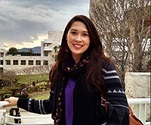Katie Chapman
Ph.D. Candidate,
Musicology
Project: Troubadour Melodies
The online database includes basic information about and transcriptions of the extant troubadour melodies as they are found in the manuscripts using searchable alpha-numeric strings designed for the font Volpiano. The site gives basic information on the manuscripts and troubadours themselves as well as tables showing concordances and totals of melodies by troubadour, manuscript, genre, and catalog number. The project also involves building on an existing search tool to add additional search options as well as developing a fuzzy search for the melodies and exploring analysis possibilities using text mining tools on the encoded melodies. My dissertation also applies statistical analysis programs to the texts of the troubadour poems and related works, as well as using mapping software to visualize the transmission of the troubadour corpus.
Jason Choi
BA Student
Major: Information Systems, Minor: Music, Kelley School of Business
Project: Research on musicians and how technology influences their composition in classical music.
The purpose of my research is to understand how enhanced technology influences musicians in the way they perceive and create music. Due to the rapid development of technology, it changed the way music being created and recognized. For instance, MIDI software enabled people to compose without even playing any instruments. MP3 players and streaming services changed the way we listen to music.
Due to these changes, I raised a question of whether technological advancement is simply an enhancement of tools or a change in a way musicians compose. I will study this topic through interviews with classical music composers and asking their perception of composition projects which involved technology and which haven’t.
Erica Hayes
MLIS Student,
School of Informatics and Computing
Project: A Digital and Naturalistic Landscape of Thomas Hardy's Wessex
Twitter: @ericayhayes
My project exhibits a GIS map of Wessex, the fictional setting in the novels and poems of nineteenth century British author and poet, Thomas Hardy. Based on the six counties in the southern region of England, Hardy named his imaginary landscape after the medieval Anglo-Saxon kingdom that existed there prior to the Norman conquest. Although many of the locations in Wessex are given fictitious names, they are very close to the real names of their corresponding locations in the southern region of England. The creation of Wessex made its first appearance in chapter 50 of the serialized version of Hardy’s novel, Far from the Madding Crowd. After receiving positive responses from readers, Hardy continued to use Wessex in his next novels. In his sixth novel, The Return of the Native, he began to divide Wessex into different regions and when it came time for Hardy to revise his earlier works for newer editions, he entitled them The Wessex Novels. In 1891 the first illustrated map of Wessex was published anonymously in The Bookman, a monthly magazine printed in London. Since the first illustrated map of Wessex, there have been numerous updated drawings of the map of Wessex published in various editions of Hardy’s novels. For this reason, when we read Hardy’s novels today, we get a fully-realized picture of Hardy’s fictional world. Due to the central element Wessex serves in Hardy’s fiction, a digital mapping of Wessex is highly ideal.
Starting with one of his most famous novels, Tess of the d’Urbervilles, my project maps the novel’s narrative through its locations in the order in which they first appear in the novel. Using the New York Public Library’s open source mapping tool, Map Warper, I have geo-rectified a digitized edition of Thomas Hardy’s illustrated map of Wessex and aligned it in ArcGIS Online with a basemap of its real locations in today’s southern region of England. The digital map of Wessex allows scholars and students to explore the towns and locations in Thomas Hardy’s Wessex and compare them to their real locations of today’s southern region of England. More than a mere setting in Hardy’s fiction, my future project goals include exploring the significance of space in the natural world Hardy captures in his writings and continuing to build upon the digital map I have created to incorporate Hardy’s other novels (e.g. The Return of the Native, Far from the Madding Crowd, Jude the Obscure, etc.). I’d also like to explore Hardy’s prevalent themes of naturalism and predeterminism in connection to the towns and places in Wessex using quantitative textual analysis methods. As I move forward with this project, I hope my map will serve as a teaching tool and offer new literary insights into Hardy’s fictional world, life and writings
Alison Martin
Ph.D. Candidate,
Ethnomusicology
Project: Musical and Sonic Dimensions of Gentrification
My work centers around the musical and sonic dimensions of gentrification in Washington, DC. For this project, I will construct a digital story map that explores and documents the relationship between the go-go musical community and Washington, DC. Go-go music is a subgenre of funk music local to DC, and through its highly percussive, energetic live performances, has served as cultural staple of black life in the city for over 40 years. Story maps allow for a map to be used to as a narrative device utilizing multimedia images, sounds,videos, and more. The go-go story map will provide an in depth look at places significant to the go-go community, such as record stores, venues, and neighborhoods, as well as how these places are being affected by gentrification. This project intervenes in the intersection of digital humanities, ethnomusicology, and black studies, as I explore the ways in which black musicians in DC have used music to construct senses of place.





